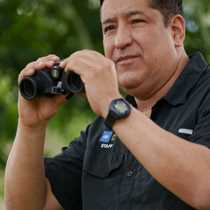The Pacaya–Samiria National Reserve is one of the largest protected areas in Peru with an area of more than 5 million acres (7,700 ml², 20,800 km²). In comparison this huge reserve is equivalent in size to the state of New Jersey. The reserve is also the largest protected seasonal flooded forest in South America. The reserve is made up of three hydrographical basins: the Samiria River drainage, the Pacaya River drainage and the Yanayacu-Pucate drainage. Today we are visiting Pacaya drainage basin.
Early in the morning we headed to the Pacaya River. In this area we observed many bird species like flycatchers, egrets, hawks, parrots and storks. One of the highlights was the sighting of prehistoric-looking hoatzin (ophistocomus hoazin). This beautiful bird species is one of the representatives of the Neotropics. In addition to the many animal species, which included a couple of squirrel monkey troops and pink river dolphins, we had the thrill to have our breakfast outdoors onboard the skiffs! This experience, as you can imagine, is just great! We had our first meal of the day served in the rainforest in the most fashionable way, with white gloves in the hands of or naturalists and fabric napkins included. We found beautiful shade for this memorable breakfast. Once onboard and before lunch we had an amusing activity, a cooking lesson of a regional dish called “Juane.”
In the afternoon we had a cultural talk about how people live in the reserve, including learning how to use the blowgun. Accompanied by bright sun, but with the breeze hitting in our faces, we started a little earlier than usual at 3:00 p.m. with the intention to go as far as we could inside the Pacaya River. We arrived to a very large lake known as Yanayacu. The afternoon was very hot, therefore the water felt wonderful. We had the surreal company of several pink river dolphins (inia geoffrensis) that were seen at a short distance swimming in the same place with us. After swimming we continued exploring and our efforts were rewarded by the observation of a couple of troops of the largest monkey species of the reserve, the red howler monkey (alouatta seniculus).
Later in the evening at around 6:15 p.m., with the sunset already on the horizon, we came back on board. We had a wonderful mix, the feeling of well-being and the certainty that we were – at least for some hours – part of the intricate and magical complexity of the Amazon region.









